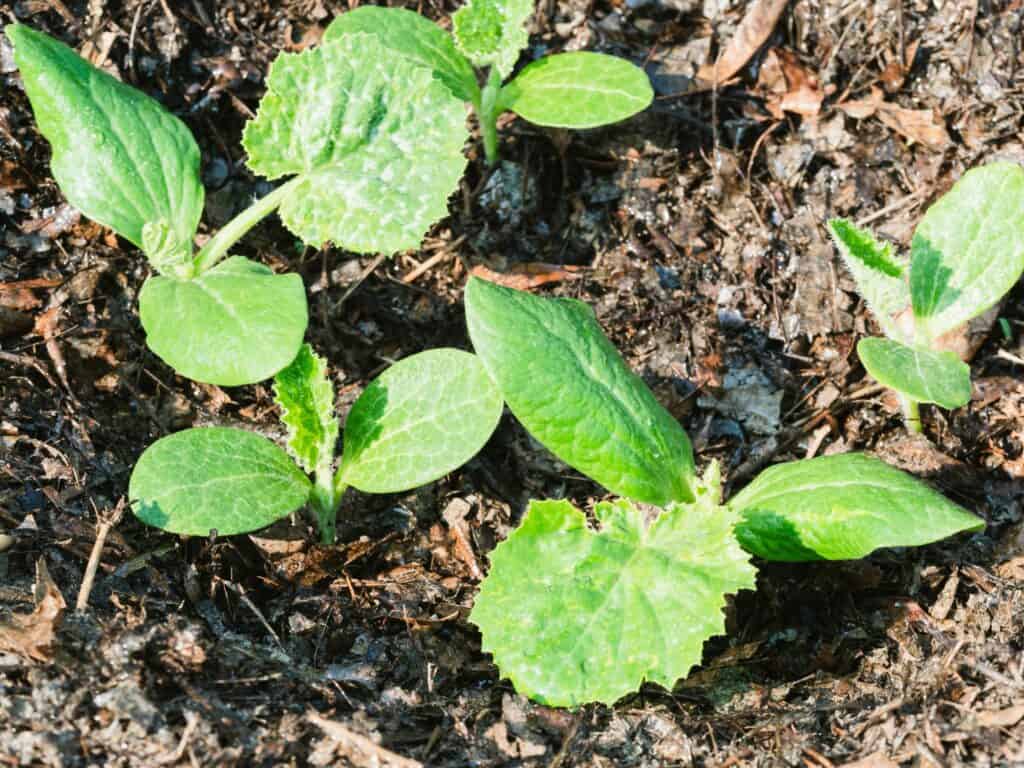White spots on squash leaves can be a common issue for gardeners, but luckily, it is not a problem without a solution.
The first step in getting rid of white spots on squash leaves is recognizing them. These white spots are usually caused by powdery mildew, a fungal disease that can affect a variety of plants.
Understanding the causes of powdery mildew is key to preventing it from infecting your squash plants in the first place.
Warm, humid weather is a prime environment for the growth of powdery mildew, so it’s important to keep your plants well-ventilated and avoid overcrowding.
Identifying susceptible species and planting them in areas with good air circulation can also help prevent the spread of powdery mildew.
If powdery mildew does infect your squash plants, there are several treatment methods available. These include using natural remedies like baking soda and neem oil, as well as commercial fungicides.
It’s important to carefully follow the instructions on any products you use to ensure their effectiveness and avoid damage to your plants. Additionally, proper post-infection care can help prevent the spread of powdery mildew to other plants in your garden.
Key Takeaways
- Recognize white spots on squash leaves as a sign of powdery mildew.
- Prevent powdery mildew by keeping plants well-ventilated and avoiding overcrowding.
- Treat powdery mildew with natural remedies or commercial fungicides, and practice proper post-infection care.
Learn more from this related post:
White Spots on Plant Leaves: 5 Causes, Solutions & Best Care Tips
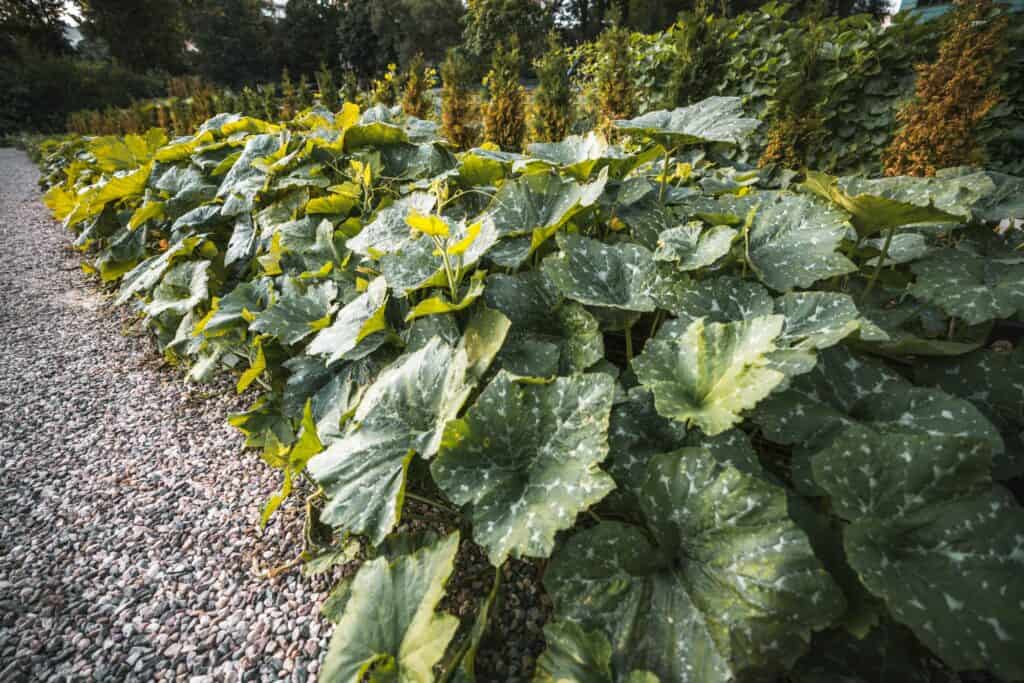
Recognizing White Spots on Squash Leaves
White spots on squash leaves are a common indication of powdery mildew, a fungal disease that affects the leaves of squash plants. Powdery mildew appears as a white powder on the leaves of infected plants.
The white powder is a fungus that grows on the surface of the leaves and stems, and it can spread quickly if not treated.
The white spots can appear on the upper or lower surface of the leaves, and they can be circular or irregular in shape. The spots can range in size from small specks to large patches that cover the entire leaf. As the disease progresses, the spots can merge together, and the leaves can become distorted and yellow.
Powdery mildew thrives in warm, humid conditions, and it is more common in late summer and early fall. The disease is spread by spores that are carried by the wind, and it can infect both new and mature leaves.
If left untreated, powdery mildew can weaken the plant and reduce its yield. It is important to recognize the symptoms of powdery mildew early and take action to prevent the disease from spreading.
How to Easily Get Rid of White Spots on Squash Leaves
White spots on squash leaves are usually caused by a fungal disease called powdery mildew. This disease is caused by several closely related fungi, including Erysiphe cichoracearum and Podosphaera xanthii.
These fungi can infect a wide variety of plants, including squash, pumpkins, and zucchinis.
Powdery mildew is a common problem in warm and humid weather conditions. The disease spreads through spores that are carried by the wind, insects, or human activities such as watering or pruning.
Once the spores land on a plant, they start to grow and form a white, powdery coating on the leaves, stems, and fruits.
The fungal growth can reduce the plant’s ability to photosynthesize and produce fruit, leading to stunted growth and reduced yields.
In severe cases, the leaves can turn yellow and die, which can weaken the plant and make it more susceptible to other diseases and pests.
There are several factors that can increase the risk of powdery mildew infection, including poor air circulation, high humidity, overcrowding, and lack of sunlight.
Plants that are stressed or have nutrient deficiencies are also more vulnerable to fungal diseases.
To prevent powdery mildew, it is important to maintain healthy plants by providing proper growing conditions, such as good soil drainage, adequate spacing, and regular watering.
It is also recommended to remove infected plant parts and dispose of them properly to prevent the spread of the disease.
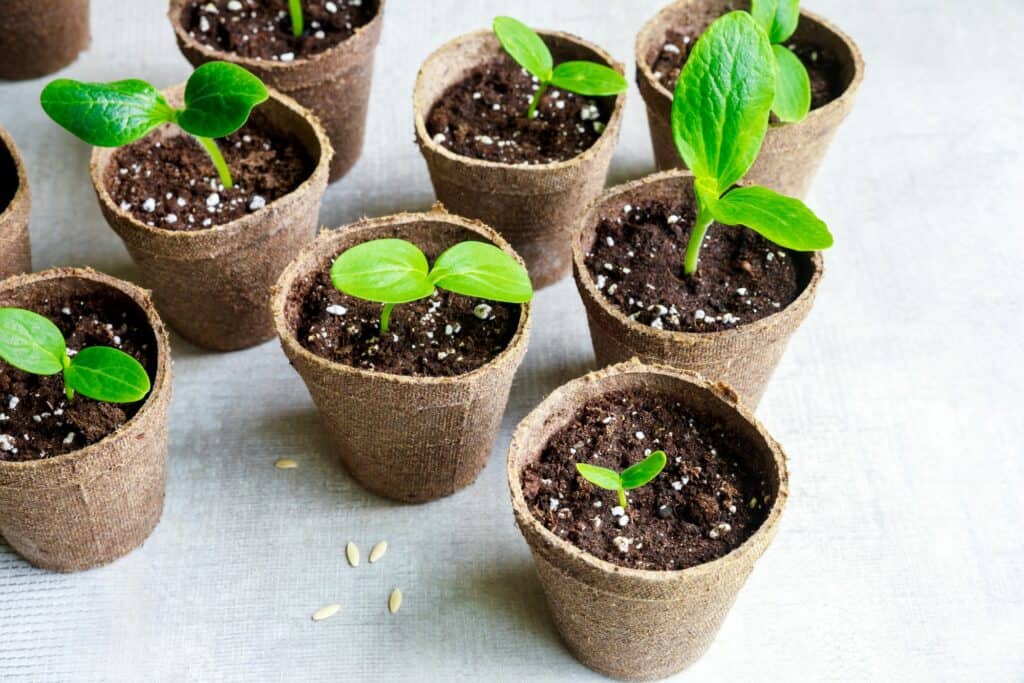
Prevention Strategies
Preventing white spots on squash leaves is easier than treating them. Here are some strategies that can help prevent the occurrence of white spots on squash leaves:
1. Plant Resistant Varieties
Planting resistant varieties of squash is one of the most effective ways to prevent powdery mildew. Resistant varieties are available in the market, and they have been bred to resist powdery mildew.
These varieties are resistant to the fungus that causes powdery mildew and can help prevent the disease from spreading.
2. Air Circulation and Sunlight
Good air circulation is essential for preventing powdery mildew. Squash plants should be spaced apart to allow for good air circulation. Poor air circulation can lead to high humidity, which can encourage the growth of powdery mildew.
Additionally, squash plants should be planted in an area with full sun exposure. Squash plants that receive direct sunlight for at least six hours a day are less likely to develop powdery mildew.
3. Proper Watering
Over-watering can lead to the development of powdery mildew. Squash plants should be watered regularly, but not excessively.
Watering should be done early in the day to allow the foliage to dry before nightfall. Wet foliage can encourage the growth of powdery mildew.
4. Temperature and Humidity Control
Powdery mildew thrives in warm and humid conditions. Squash plants should be grown in an area with moderate temperatures and humidity levels.
High humidity can be controlled by watering the plants early in the day and ensuring good air circulation.
5. Mulch
Mulching around the base of the squash plants can help prevent the growth of powdery mildew. Mulch can help keep the soil moist and cool, which can prevent the growth of powdery mildew.
However, over-mulching can lead to excessive moisture, which can encourage the growth of powdery mildew.
6. Foliage Maintenance
Regular maintenance of the foliage is important for preventing powdery mildew. Dead or diseased foliage should be removed promptly.
This will help prevent the spread of powdery mildew to healthy foliage. Additionally, over-fertilizing can lead to the development of powdery mildew.
Squash plants should be fertilized according to the manufacturer’s instructions.
Identifying Susceptible Species
Powdery mildew is a common fungal disease that affects a wide variety of plants, including many that are grown in home gardens. However, some species are more susceptible to powdery mildew than others.
Squash plants, including zucchini, winter squash, pumpkins, and other varieties, are particularly susceptible to powdery mildew. In fact, powdery mildew is one of the most common diseases that affect squash plants.
The leaves of squash plants are especially vulnerable to powdery mildew, and the disease can quickly spread from leaf to leaf and plant to plant.
Cucumbers, melons, and gourds are also susceptible to powdery mildew. These plants are all part of the same family as squash, and they share many of the same characteristics.
Like squash plants, the leaves of cucumber, melon, and gourd plants are susceptible to powdery mildew, and the disease can quickly spread throughout the plant if left untreated.
Tomatoes and peppers are also at risk for powdery mildew, but they are generally less susceptible than squash plants.
However, if the conditions are right, powdery mildew can still take hold and cause damage to these plants.
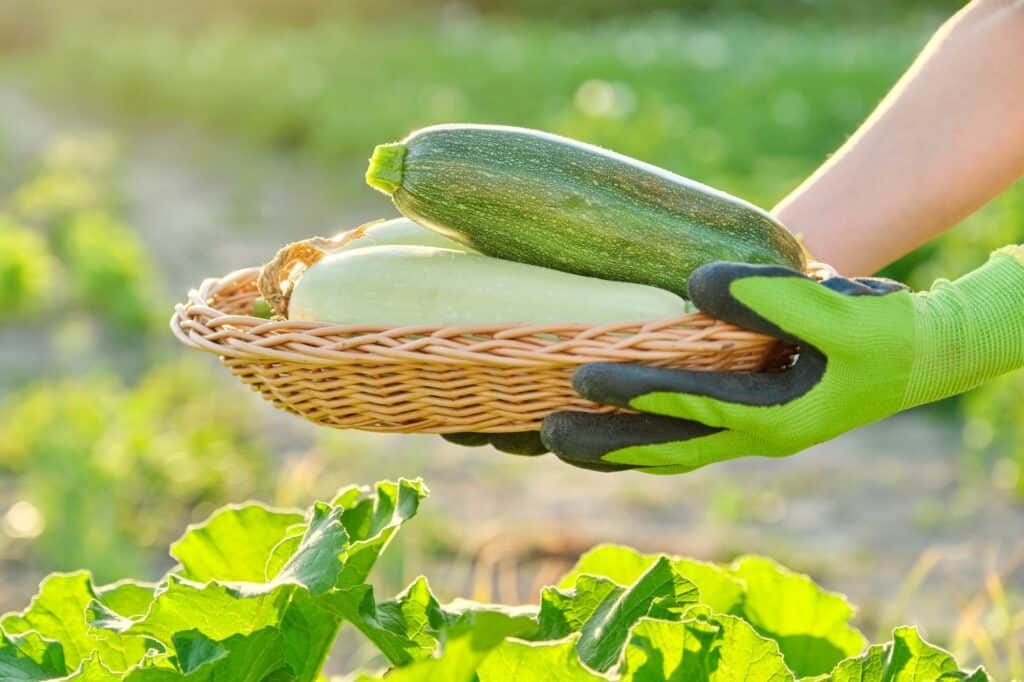
Treatment Methods
There are several effective treatment methods for getting rid of white spots on squash leaves. These include both chemical and organic options.
One chemical option is to use a fungicide. Fungicides are chemicals that can kill or prevent the growth of fungi. There are many different types of fungicides available, including both organic and chemical options. Some common chemical fungicides include sulfur powder and wettable sulfur. These can be applied to the infected foliage using a spray bottle.
Another chemical option is to use horticultural oil. Horticultural oil is a type of oil that can be applied to plants to control a variety of pests and diseases. It works by suffocating the insects or fungi that are causing the problem. Horticultural oil can be applied using a spray bottle.
For those who prefer organic options, neem oil is a popular choice. Neem oil is a natural oil that is derived from the neem tree. It has insecticidal and fungicidal properties and can be used to control a variety of pests and diseases. Neem oil can be applied using a spray bottle.
Another organic option is to use vinegar. Vinegar is a natural acid that can help to kill fungi. To use vinegar as a treatment, mix equal parts vinegar and water and apply to the infected foliage using a spray bottle.
In addition to using chemicals or organic treatments, pruning infected foliage can also be effective. Pruning involves removing infected leaves or branches from the plant to prevent the spread of the disease. It is important to use clean pruning shears to avoid spreading the disease to other parts of the plant.
Post-Infection Care
Once white spots appear on squash leaves, it’s important to take action to prevent further spread of the infection. Here are some post-infection care tips to control powdery mildew and other fungal diseases on squash plants:
- Remove Dead Leaves: Remove any infected leaves as soon as you spot them. This will prevent the spread of the infection to healthy parts of the plant. Use pruning shears or scissors to cut off the infected leaves and dispose of them in the trash.
- Avoid Overhead Watering: Overhead watering can promote the growth of powdery mildew. Instead, water the soil around the base of the plant. This will keep the leaves dry and reduce the risk of infection.
- Increase Air Circulation: Proper air circulation can help prevent powdery mildew. Space plants out to increase air flow around them. Also, avoid planting in areas with heavy wind or weather conditions that can cause damages to the leaves.
- Fertilize and Compost: Healthy plants are more resistant to pests and diseases. Fertilize squash plants with a balanced fertilizer to promote healthy growth. Adding compost to the soil can also increase the number of beneficial microorganisms in the soil, which can help prevent fungal infections.
- Apply Baking Soda: Baking soda can help control powdery mildew on squash plants. Mix one tablespoon of baking soda with one gallon of water and spray the solution on the leaves. Repeat every one to two weeks as needed.
- Use Tools Properly: Use clean pruning shears or scissors to remove infected leaves. This will prevent the spread of the infection to healthy parts of the plant. Also, clean tools with rubbing alcohol or a bleach solution before and after use to prevent the spread of pests and diseases.
- Clean Up Plant Debris: Powdery mildew can overwinter on plant debris. So, make sure to clean up all the leaves and plant debris out of your beds in the fall. This will help prevent the spread of the infection to next year’s crop.
By following these post-infection care tips, gardeners can control powdery mildew and other fungal diseases on squash plants.
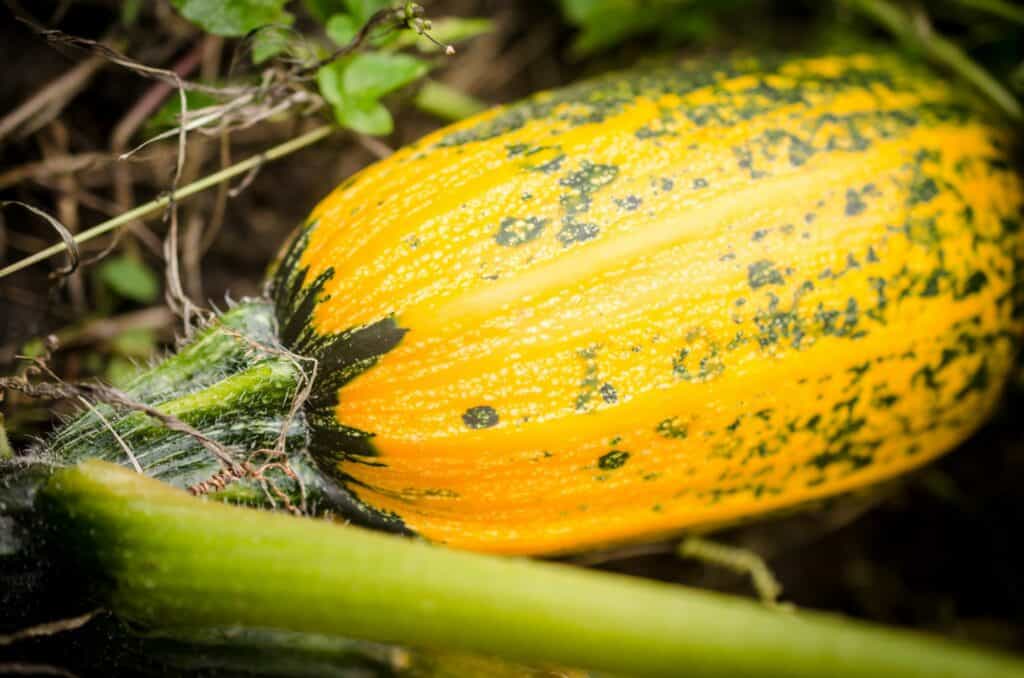
Impact on Fruit and Plant Productivity
White spots on squash leaves can have a significant impact on the plant’s productivity and fruit production.
When the leaves are covered with white powdery mildew, they cannot perform photosynthesis effectively, which is necessary for the plant to produce energy and grow. This can lead to stunted growth, smaller fruits, and a lower yield.
In addition, the fungus can spread to the fruit, causing it to rot and become inedible. This is not only a loss for the grower but also for the consumer who is expecting to purchase healthy and fresh produce.
If left untreated, the powdery mildew can also weaken the plant, making it more susceptible to other diseases and pests. This can lead to a further reduction in productivity and fruit quality.
To prevent these negative impacts, it is important to take action as soon as the white spots are noticed on the squash leaves. By implementing proper care and treatment, growers can ensure a healthy and productive crop.
Additional Tips for Healthy Squash Plants
To ensure healthy squash plants, there are a few additional tips to keep in mind.
Growing and Compost
Squash plants prefer well-draining soil that is rich in organic matter. Adding compost to the soil can help improve nutrient levels and increase beneficial microorganisms. It is recommended to add compost to the soil before planting and then again as a top dressing during the growing season.
Watering and Temperature
Squash plants require consistent watering, especially during hot and dry weather. However, over-watering can lead to root rot and other diseases.
It is recommended to water deeply once a week, rather than frequent shallow watering. Squash plants also prefer warm soil temperatures, so it is recommended to plant them after the last frost date in your area.
Spacing and Humidity
Squash plants require adequate spacing to prevent overcrowding, which can lead to disease and poor growth. It is recommended to plant squash plants at least 2-3 feet apart.
Squash plants also prefer high humidity, so it is recommended to mulch around the base of the plants to help retain moisture.
Wind and Insects
Squash plants can be susceptible to wind damage, especially during storms. It is recommended to stake or cage the plants to help support them.
Squash plants can also attract certain insects, such as squash bugs and vine borers. It is recommended to monitor the plants regularly and use appropriate insecticides if needed.
Tools and Hands
When working with squash plants, it is important to use clean tools and hands to prevent the spread of disease.
It is recommended to sanitize tools and wash hands before and after working with the plants.
Nursery and Vegetable Garden
When purchasing squash plants from a nursery, it is important to choose healthy plants that are free from disease and pests.
When planting in a vegetable garden, it is recommended to rotate crops to prevent disease buildup in the soil.
By following these additional tips, gardeners can help ensure healthy and productive squash plants.
Frequently Asked Questions
What causes powdery mildew on squash leaves?
Powdery mildew is a fungal disease caused by different species of fungi. The most common fungi that cause powdery mildew on squash leaves are Erysiphe cichoracearum and Podosphaera xanthii. These fungi thrive in warm and humid conditions, and they can easily spread through the air.
How do I identify powdery mildew on my squash plants?
Powdery mildew on squash leaves appears as white or gray powdery spots on the upper surface of the leaves.
As the disease progresses, the spots can become larger and merge together, covering the entire leaf surface. Infected leaves may also curl, twist, or become distorted.
What are some natural remedies for powdery mildew on squash?
There are several natural remedies that can help control powdery mildew on squash leaves. One of the most effective remedies is to spray the plants with a mixture of water and baking soda.
Another option is to use a mixture of milk and water. Additionally, neem oil, garlic oil, and compost tea can also be effective in controlling powdery mildew.
Can white spots on squash leaves be a sign of a fungal disease?
Yes, white spots on squash leaves can be a sign of a fungal disease, particularly powdery mildew.
However, it is important to note that not all white spots on squash leaves are caused by fungal diseases. Some varieties of squash naturally have white markings on the leaves.
How can I prevent powdery mildew from spreading to other plants?
To prevent powdery mildew from spreading to other plants, it is important to remove infected leaves as soon as possible.
Additionally, it is recommended to space the plants properly to allow for good air circulation, water the plants at the base to avoid wetting the leaves, and avoid overhead watering.
Is it safe to eat squash with powdery mildew on the leaves?
While powdery mildew on squash leaves is unsightly, it is generally not harmful to humans. However, it can affect the plant’s growth and yield, so it is best to control the disease to ensure a healthy harvest.
If you are concerned about consuming squash with powdery mildew on the leaves, you can simply remove the affected leaves before consuming the fruit.

Hey, I’m Lisa and I’ve been an avid gardener for over 30 years. I love writing, talking and living in the garden! Feel free to connect with me on my socials below

